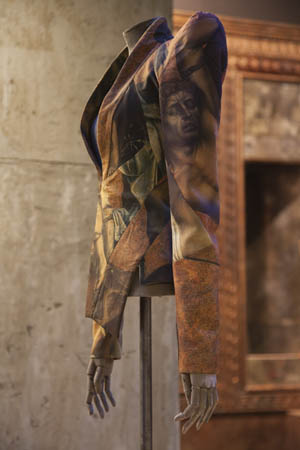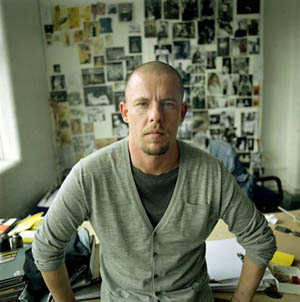|
THE ALEXANDER
MCQUEEN EXHIBIT
closed on August 7, 2011 after a run as one of New York Metropolitan
Museum of Art’s most viewed exhibitions. Amidst swirling rumours
that it may be heading to the Victoria & Albert Museum in London,
a look back on the mastermind who was the subject of the exhibit
is well in order.
The Costume Institute at the Metropolitan Museum of
Art in New York City recently hosted Alexander McQueen: Savage
Beauty. Located on the second floor in the Iris and B. Gerald
Cantor Exhibition Hall, the exhibit was immensely popular, with
a seemingly never-ending long line of guests impatiently waiting
to enter McQueen’s amazing world of beauty at its best. Curated
by Andrew Bolton, the fascinating journey allowed visitors to explore
beautiful and stunning pieces created by Lee Alexander McQueen and
the museum welcomed guests into the spectacular retrospective that
served as homage to McQueen’s artistic creations.
McQueen created remarkable pieces that not only represent
fashion but also symbolize inspiring and artistic features that
arouse one’s imagination. Once saying, ‘I like to think of myself
as a plastic surgeon with a knife,’ the outstanding designer truly
had a way of dissecting every angle and section of each of his wonderfully
magnificent creations.
He was a great artist with a remarkable sense of fashion,
whose every piece was innovative, original and meticulously detailed.
He used an array of colours as though he was painting a mural and
he designed each piece as if he were sculpting. With almost 100
ensembles, 70 accessories and a number of videos, the beautifully
organized exhibition highlighted the late designer’s hard work and
fantastic features in a manner that literally took everyone’s breath
away.
The exhibition presents pieces from throughout McQueen’s
19-year career starting with his graduate collection at Central
St Martin’s in 1992 and ending with the final runway show that occurred
shortly after his death. As guests walk from one gallery to the
next, they step into a new theme: Romantic Mind, Romantic Gothic
and Cabinet of Curiosities, Romantic Nationalism, Romantic Exoticism,
Romantic Primitivism and Romantic Naturalism.
The collections reveal ingenuity and innovative skill
with opposing elements coming together to create masterpieces, this
melding together of opposition reflecting McQueen’s statement, ‘I
oscillate between life and death, happiness and sadness, good and
evil.’
The entrance exposes a fascinating welcome to the world
of Alexander McQueen, an amazing red and black ostrich feather dress
complete with glass medical slides painted red and a dress made
from razor-clam shells, both items from his VOSS spring–summer 2001
collection acting as the first pieces to greet the visitors.
The calm, dark and serene atmosphere forms a majestic
ambiance as a number of pieces emerge one after the other. The first
gallery mainly contains jackets, perfectly tailored and artistically
designed. In the next room’s dark and theatrical setting, a coat
of black parachute silk from the Supercalifragilisticexpialidocious
autumn–winter 2002–3 collection magnificently blows in the wind
as aged mirrors surround it. A pair of black synthetic pants and
a black silk satin hat made by Philip Treacy for Alexander McQueen
accompany the mysterious all-black ensemble and this Cabinet of
Curiosities is filled with accessories and more artistic creations,
many designed by McQueen in collaboration with other accessory designers.
The wondrous spectacle continues as a mini three-dimensional
show takes place within a large glass prism and a hologram from
the Widows of Culloden autumn–winter 2006–7 collection features
model Kate Moss gracefully twirling in a dress of silk organza and
tulle.
McQueen was chief designer at Givenchy from 1996 to
2001. He continued to create skilfully original designs for his
own label and in 2006 he launched the McQ label.
He once said, ‘Working in the atelier [at Givenchy]
was fundamental to my career … Because I was a tailor, I didn’t
totally understand softness or lightness … But working at Givenchy
helped me learn my craft.’
Each of McQueen’s exquisite pieces are mesmerizing
and inspiring to look at. Throughout the tour, one ensemble continues
to lead to another, making the awestruck guests yearn for more.
A dress with nude silk organza embroidered with silk and fresh flowers
from the Sarabande spring–summer 2007 collection embodies
the meticulous delicacy and stylish appeal that is visible throughout
McQueen’s work. Many pieces also include animal fur, underscoring
a statement McQueen once made about the relationship between animals
and humans: ‘We use a lot of real skins—animal skins, but they were
all by-products. None were killed for their fur; they have all been
killed for their meat … a play on animal and man. They are both
gross and very much the same.’ A fierce and creative bodysuit from
the It’s a Jungle Out There autumn–winter 1997–8 collection
is made of brown leather with bleached denim and taxidermy with
the pair of crocodile heads on the shoulder of the jacket acting
as the highlight of the ensemble. A jacket from the same collection
includes long impala horns on pony skin, the effect of this jacket
just as awe-inspiring as the first.
Just as the magnificent exhibit appears to wind to
a close, guests enter a showcase of the ensembles from the last
collection that was presented before the designer’s sudden death:
Plato’s Atlantis spring–summer 2010. The garments are contemporary
and inspirational, their modernity underscored by a video projected
onto the back wall that shows colourful snake images coming to life
then suddenly vanishing and turning into a human-like figure. The
garments revolve around raw material and figures of nature, reflecting
the influential part that nature’s beauty played in McQueen’s career.
He admitted, ‘I have always loved the mechanics of nature and to
a greater or lesser extent my work is always informed by that.’
The talented designer’s death in February 2010 at the
tender age of 40 was a shock and loss to people in and around the
fashion industry. Alexander McQueen: Savage Beauty is a tribute
to the legendary British fashion designer who will always be known
for his amazingly innovative and creatively bold designs. McQueen’s
innovation is visible in his daring designs which illustrate that
women should feel free to dress as they please and his attitude
towards fashion can be summed up in this quote: ‘I want to be the
purveyor of a certain silhouette or a way of cutting, so that when
I’m dead and gone people will know that the twenty-first century
was started by Alexander McQueen.’ •
|
 |

Above Coat from the Romantic Mind section at Alexander
McQueen: Savage Beauty.

British Fashion Council
‘There’s no way back for me now, I am going to take you on
journeys you’ve never dreamed possible.’
Alexander McQueen
Lola Saab is Paris editor of Lucire.
|

